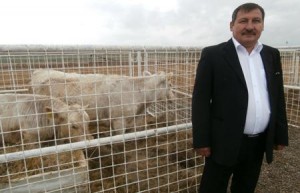 AKTOBE REGION – Authorities in Aktobe are focusing on cattle farming in their regions, commissioning feedlots and providing funds for the purchase of breeding animals.
AKTOBE REGION – Authorities in Aktobe are focusing on cattle farming in their regions, commissioning feedlots and providing funds for the purchase of breeding animals.
To provide the region with productive livestock and increase the export potential of Kazakh-produced meat, Aktobe authorities are turning their attention to developing domestic breeds, such as the Auliekol and Kazakh Whitehead breeds. The regional budget last year allocated 244.7 million tenge (US$1.3 million) to help improve herds in 36 villages and pay for 680 breeding animals. Recently, two feedlots for 1,500 and 1,000 animals each were commissioned for the Reymkul farming partnership in the Alga district and the Zhantizer partnership in the Khromtau district, both of which breed domestic beef cattle.
Samat Kaldygulov, leader of the Reymkul partnership, bought the first batch of Auliekol cattle in 2010 in the Kostanai region. The Auliekol breed was developed in the early 1990s by Kazakh scientists by crossbreeding three groups of beef cattle: Franco-Italian Charolais, Canadian Aberdeen-Angus and Kazakh Whitehead. The end result was a new, highly productive breed of domestic beef animals that meet international standards and are also well adapted to difficult climatic conditions.
For the third year, the farmers of the partnership have received a good animal yield. Last year, they sold dozens of seed bulls from their yield. The animals gain up to 400 kilogrammes a year and up to 500 kg in 18 months. An adult bull will generally reach 760 kg. Today, the partnership has 500 animals and Kaldygulov said that he plans to increase their beef exports. He has opened his own meat processing plant in the oblast centre.
The Zhantizer farming partnership has nine hectares of hay and grasslands and fields for forage crops. They recently upgraded their technical park and, through their ongoing development, are providing jobs and incomes to Alga district workers.


